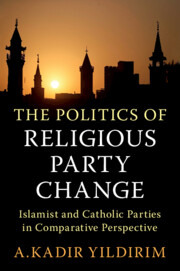Book contents
- The Politics of Religious Party Change
- Cambridge Studies in Social Theory, Religion, and Politics
- The Politics of Religious Party Change
- Copyright page
- Contents
- List of Figures
- List of Tables
- Acknowledgments
- Introduction
- 1 Explaining Religious Party Change
- 2 Catholic and Islamic Religious Institutions
- 3 Anticlericalism, Religious Revival, and the Rise of Religious Political Identities
- 4 The Origins of Religiopolitical Identity
- 5 Intraparty Conflict
- Conclusion
- Bibliography
- List of Interviews
- Index
1 - Explaining Religious Party Change
Published online by Cambridge University Press: 22 December 2022
- The Politics of Religious Party Change
- Cambridge Studies in Social Theory, Religion, and Politics
- The Politics of Religious Party Change
- Copyright page
- Contents
- List of Figures
- List of Tables
- Acknowledgments
- Introduction
- 1 Explaining Religious Party Change
- 2 Catholic and Islamic Religious Institutions
- 3 Anticlericalism, Religious Revival, and the Rise of Religious Political Identities
- 4 The Origins of Religiopolitical Identity
- 5 Intraparty Conflict
- Conclusion
- Bibliography
- List of Interviews
- Index
Summary
This chapter reviews the existing literature on religious party change. The scholarly literature offers three major explanations for the divergence we observe in Catholic and Islamist parties’ trajectories and for why religious parties change, or moderate: religious, political, and institutional explanations. Despite major contributions to our understanding of religious parties, the literatures on Catholic and Islamist parties grew virtually independent of each other, focusing on entirely different sets of questions or factors that explain change in these parties. Building on the existing literature, this chapter lays out the theory developed in this book to explain religious party change. First, an overview of the political economic approach to the study of religion is presented; next, the chapter outlines the effect of institutions on political behavior, and in particular how religious institutions affect political behavior and religious parties. Finally, the major actors in the theory are analyzed before concluding with a comparative assessment of how Islamist and Catholic parties fit into the theory.
Keywords
- Type
- Chapter
- Information
- The Politics of Religious Party ChangeIslamist and Catholic Parties in Comparative Perspective, pp. 21 - 50Publisher: Cambridge University PressPrint publication year: 2023

